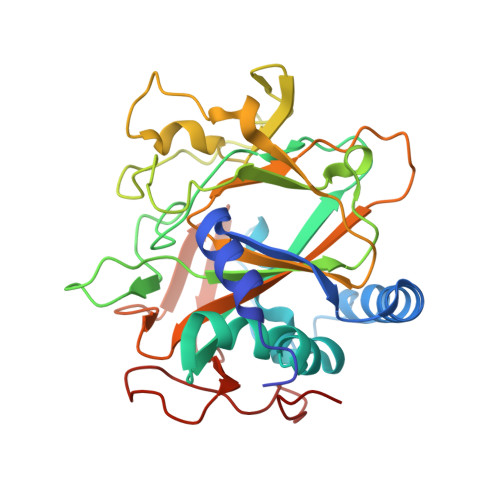Crystal structure of the non-haem iron halogenase SyrB2 in syringomycin biosynthesis.
Blasiak, L.C., Vaillancourt, F.H., Walsh, C.T., Drennan, C.L.(2006) Nature 440: 368-371
- PubMed: 16541079
- DOI: https://doi.org/10.1038/nature04544
- Primary Citation of Related Structures:
2FCT, 2FCU, 2FCV - PubMed Abstract:
Non-haem Fe(II)/alpha-ketoglutarate (alphaKG)-dependent enzymes harness the reducing power of alphaKG to catalyse oxidative reactions, usually the hydroxylation of unactivated carbons, and are involved in processes such as natural product biosynthesis, the mammalian hypoxic response, and DNA repair. These enzymes couple the decarboxylation of alphaKG with the formation of a high-energy ferryl-oxo intermediate that acts as a hydrogen-abstracting species. All previously structurally characterized mononuclear iron enzymes contain a 2-His, 1-carboxylate motif that coordinates the iron. The two histidines and one carboxylate, known as the 'facial triad', form one triangular side of an octahedral iron coordination geometry. A subclass of mononuclear iron enzymes has been shown to catalyse halogenation reactions, rather than the more typical hydroxylation reaction. SyrB2, a member of this subclass, is a non-haem Fe(II)/alphaKG-dependent halogenase that catalyses the chlorination of threonine in syringomycin E biosynthesis. Here we report the structure of SyrB2 with both a chloride ion and alphaKG coordinated to the iron ion at 1.6 A resolution. This structure reveals a previously unknown coordination of iron, in which the carboxylate ligand of the facial triad is replaced by a chloride ion.
Organizational Affiliation:
Department of Chemistry, Massachusetts Institute of Technology, Cambridge, Massachusetts 02139, USA.


















